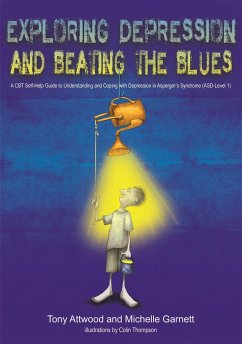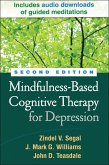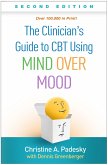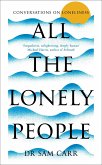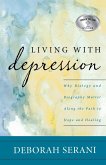Dr Anthony Attwood, Michelle Garnett
Exploring Depression, and Beating the Blues
A CBT Self-Help Guide to Understanding and Coping with Depression in Asperger's Syndrome [Asd-Level 1]
Dr Anthony Attwood, Michelle Garnett
Exploring Depression, and Beating the Blues
A CBT Self-Help Guide to Understanding and Coping with Depression in Asperger's Syndrome [Asd-Level 1]
- Broschiertes Buch
- Merkliste
- Auf die Merkliste
- Bewerten Bewerten
- Teilen
- Produkt teilen
- Produkterinnerung
- Produkterinnerung
Understand depression and how to cope with this self-help guide designed specifically for individuals on the autism spectrum. It includes a 10-stage CBT self-help programme with self-assessment tools and activities.
Andere Kunden interessierten sich auch für
![Alone Together Alone Together]() Sherry TurkleAlone Together22,99 €
Sherry TurkleAlone Together22,99 €![Mindfulness-Based Cognitive Therapy for Depression Mindfulness-Based Cognitive Therapy for Depression]() Zindel Segal (Canada University of Toronto?Scarborough)Mindfulness-Based Cognitive Therapy for Depression114,99 €
Zindel Segal (Canada University of Toronto?Scarborough)Mindfulness-Based Cognitive Therapy for Depression114,99 €![The Clinician's Guide to CBT Using Mind Over Mood The Clinician's Guide to CBT Using Mind Over Mood]() Christine A. PadeskyThe Clinician's Guide to CBT Using Mind Over Mood69,99 €
Christine A. PadeskyThe Clinician's Guide to CBT Using Mind Over Mood69,99 €![All the Lonely People All the Lonely People]() Sam CarrAll the Lonely People21,99 €
Sam CarrAll the Lonely People21,99 €![The Mindful Way Through Depression The Mindful Way Through Depression]() Mark Williams (University of Oxford (Emeritus) United Kingdom )The Mindful Way Through Depression33,99 €
Mark Williams (University of Oxford (Emeritus) United Kingdom )The Mindful Way Through Depression33,99 €![Coping After Covid-19: Cognitive Behavioral Skills for Anxiety, Depression, and Adjusting to Chronic Illness Coping After Covid-19: Cognitive Behavioral Skills for Anxiety, Depression, and Adjusting to Chronic Illness]() Abhishek Jaywant (Assistant Professor, Assistant Professor, Weill CCoping After Covid-19: Cognitive Behavioral Skills for Anxiety, Depression, and Adjusting to Chronic Illness42,99 €
Abhishek Jaywant (Assistant Professor, Assistant Professor, Weill CCoping After Covid-19: Cognitive Behavioral Skills for Anxiety, Depression, and Adjusting to Chronic Illness42,99 €![Living with Depression Living with Depression]() Deborah SeraniLiving with Depression16,99 €
Deborah SeraniLiving with Depression16,99 €-
-
-
Understand depression and how to cope with this self-help guide designed specifically for individuals on the autism spectrum. It includes a 10-stage CBT self-help programme with self-assessment tools and activities.
Produktdetails
- Produktdetails
- Verlag: Jessica Kingsley Publishers
- Seitenzahl: 272
- Erscheinungstermin: 18. August 2016
- Englisch
- Abmessung: 244mm x 172mm x 25mm
- Gewicht: 422g
- ISBN-13: 9781849055024
- ISBN-10: 1849055025
- Artikelnr.: 40757646
- Herstellerkennzeichnung
- Libri GmbH
- Europaallee 1
- 36244 Bad Hersfeld
- gpsr@libri.de
- Verlag: Jessica Kingsley Publishers
- Seitenzahl: 272
- Erscheinungstermin: 18. August 2016
- Englisch
- Abmessung: 244mm x 172mm x 25mm
- Gewicht: 422g
- ISBN-13: 9781849055024
- ISBN-10: 1849055025
- Artikelnr.: 40757646
- Herstellerkennzeichnung
- Libri GmbH
- Europaallee 1
- 36244 Bad Hersfeld
- gpsr@libri.de
Tony Attwood, PhD, is a clinical psychologist from Brisbane, Australia, with over 30 years of experience with individuals with autism spectrum disorders. He is currently Adjunct Professor at Griffith University in Queensland.
Introduction: Why we created the Exploring Depression Cognitive Behaviour
Therapy (CBT) programme. 1. Why Does Someone with Asperger's Syndrome
Become Depressed? 2. The Nature of Depression. 3. How Does Depression Look
and Feel for a Person with Asperger's Syndrome? 4. What Type of Therapy
Works for a Person with Asperger's Syndrome? 5. The Perception, Learning
and Thinking Style Associated with Asperger's Syndrome. 6. Overview of the
10-Stage CBT Programme Exploring Depression. 7. Assessment Before Starting
the Programme. 8. Stage 1: Qualities and Abilities. 9. Stage 2: What is
Depression? 10. Stage 3: Tools to Combat Depression. 11. Stage 4: Art and
Pleasure Tools. 12. Stage 5: Thinking Tools (part 1). 13. Stage 6: Thinking
Tools (part 2) and Social Tools. 14. Stage 7: Thinking Tools (part 3) and
Relaxation Tools. 15. Stage 8: Relaxation and Helpful and Unhelpful Tools.
16. Stage 9: A Safety Plan. 17. Stage 10: The Future. Recommended reading.
Appendix 1. Bringing the Body into Awareness. Appendix 2. Positive
Personality Adjectives. Appendix 3. Bringing the Five Senses into
Awareness. Appendix 4. Daily Energy Account Form. Appendix 5.
Websites/Blogspots/Support Information. Appendix 6. Relaxation for
Self-awareness. Appendix 7. Time Machine Activity. Appendix 8. Mood Diary
Dimensions.
Therapy (CBT) programme. 1. Why Does Someone with Asperger's Syndrome
Become Depressed? 2. The Nature of Depression. 3. How Does Depression Look
and Feel for a Person with Asperger's Syndrome? 4. What Type of Therapy
Works for a Person with Asperger's Syndrome? 5. The Perception, Learning
and Thinking Style Associated with Asperger's Syndrome. 6. Overview of the
10-Stage CBT Programme Exploring Depression. 7. Assessment Before Starting
the Programme. 8. Stage 1: Qualities and Abilities. 9. Stage 2: What is
Depression? 10. Stage 3: Tools to Combat Depression. 11. Stage 4: Art and
Pleasure Tools. 12. Stage 5: Thinking Tools (part 1). 13. Stage 6: Thinking
Tools (part 2) and Social Tools. 14. Stage 7: Thinking Tools (part 3) and
Relaxation Tools. 15. Stage 8: Relaxation and Helpful and Unhelpful Tools.
16. Stage 9: A Safety Plan. 17. Stage 10: The Future. Recommended reading.
Appendix 1. Bringing the Body into Awareness. Appendix 2. Positive
Personality Adjectives. Appendix 3. Bringing the Five Senses into
Awareness. Appendix 4. Daily Energy Account Form. Appendix 5.
Websites/Blogspots/Support Information. Appendix 6. Relaxation for
Self-awareness. Appendix 7. Time Machine Activity. Appendix 8. Mood Diary
Dimensions.
Introduction: Why we created the Exploring Depression Cognitive Behaviour
Therapy (CBT) programme. 1. Why Does Someone with Asperger's Syndrome
Become Depressed? 2. The Nature of Depression. 3. How Does Depression Look
and Feel for a Person with Asperger's Syndrome? 4. What Type of Therapy
Works for a Person with Asperger's Syndrome? 5. The Perception, Learning
and Thinking Style Associated with Asperger's Syndrome. 6. Overview of the
10-Stage CBT Programme Exploring Depression. 7. Assessment Before Starting
the Programme. 8. Stage 1: Qualities and Abilities. 9. Stage 2: What is
Depression? 10. Stage 3: Tools to Combat Depression. 11. Stage 4: Art and
Pleasure Tools. 12. Stage 5: Thinking Tools (part 1). 13. Stage 6: Thinking
Tools (part 2) and Social Tools. 14. Stage 7: Thinking Tools (part 3) and
Relaxation Tools. 15. Stage 8: Relaxation and Helpful and Unhelpful Tools.
16. Stage 9: A Safety Plan. 17. Stage 10: The Future. Recommended reading.
Appendix 1. Bringing the Body into Awareness. Appendix 2. Positive
Personality Adjectives. Appendix 3. Bringing the Five Senses into
Awareness. Appendix 4. Daily Energy Account Form. Appendix 5.
Websites/Blogspots/Support Information. Appendix 6. Relaxation for
Self-awareness. Appendix 7. Time Machine Activity. Appendix 8. Mood Diary
Dimensions.
Therapy (CBT) programme. 1. Why Does Someone with Asperger's Syndrome
Become Depressed? 2. The Nature of Depression. 3. How Does Depression Look
and Feel for a Person with Asperger's Syndrome? 4. What Type of Therapy
Works for a Person with Asperger's Syndrome? 5. The Perception, Learning
and Thinking Style Associated with Asperger's Syndrome. 6. Overview of the
10-Stage CBT Programme Exploring Depression. 7. Assessment Before Starting
the Programme. 8. Stage 1: Qualities and Abilities. 9. Stage 2: What is
Depression? 10. Stage 3: Tools to Combat Depression. 11. Stage 4: Art and
Pleasure Tools. 12. Stage 5: Thinking Tools (part 1). 13. Stage 6: Thinking
Tools (part 2) and Social Tools. 14. Stage 7: Thinking Tools (part 3) and
Relaxation Tools. 15. Stage 8: Relaxation and Helpful and Unhelpful Tools.
16. Stage 9: A Safety Plan. 17. Stage 10: The Future. Recommended reading.
Appendix 1. Bringing the Body into Awareness. Appendix 2. Positive
Personality Adjectives. Appendix 3. Bringing the Five Senses into
Awareness. Appendix 4. Daily Energy Account Form. Appendix 5.
Websites/Blogspots/Support Information. Appendix 6. Relaxation for
Self-awareness. Appendix 7. Time Machine Activity. Appendix 8. Mood Diary
Dimensions.

